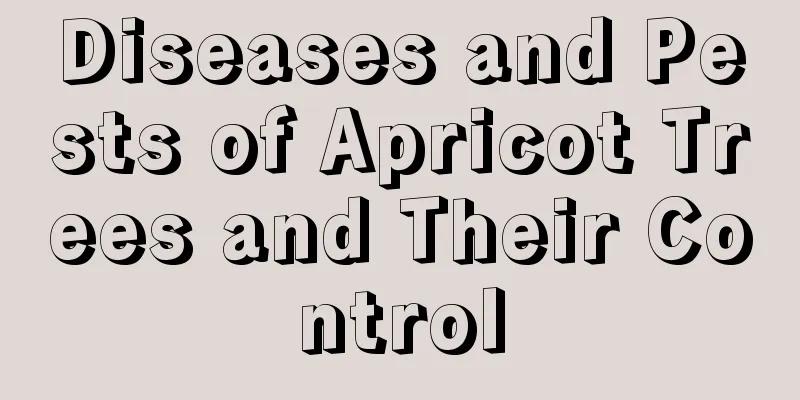Diseases and Pests of Apricot Trees and Their Control

Diseases of apricot trees and their prevention and treatmentApricot brown rotApricot brown rot mainly harms the fruit, and the disease can occur from young fruit to fruit maturity. It also harms flowers and leaves. At the early stage of the disease, round brown spots appear on the surface of the fruit, which then quickly expand, soften and rot. In the later stage, velvety particles arranged in a ring-like pattern appeared on the surface of the lesions, which were yellow-brown in color, and the diseased fruits mostly fell off at an early stage. Specific prevention and control methods are as follows: 1. Reasonable pruning and timely summer pruning can make the orchard ventilated and light-permeable. 2. In winter, clean up and burn diseased fruits and fallen leaves to eliminate the source of the disease. 3. Before the buds sprout, you can spray 1:1:100 Bordeaux mixture, etc. After the flowers fall, you need to immediately spray 800 times of 80% mancozeb, etc., and then spray 600~800 times of 70% methyl thiophanate or 500~600 times of 75% thiophanate-methyl wettable powder or 600 times of 50% carbendazim wettable powder every 10-14 days. Apricot tumorThe disease can harm the flowers and fruits, new shoots and leaves of apricot trees. Typically, symptoms appear after flowers fall and when new shoots grow to more than 15 cm. Specific symptoms include slow elongation of affected shoots, which are dark red at first and then turn yellow-green, with small yellow-brown slightly raised spots appearing on them. The diseased shoots are prone to withering, and the fruits on them often shrink and fall off. Prevention and control methods: When new shoots or leaves begin to show symptoms, they should be cut off in time and burned in batches to eliminate the source of the disease. If this continues for 2-3 years, the condition can be basically controlled. Apricot bacterial punchThe disease mainly harms leaves, but also fruits and new shoots. The symptoms on the affected leaves are the initial appearance of water-soaked spots, which gradually expand into spots about 2 mm in diameter and are circular or irregular in shape. When the diseased and dead tissue begins to dry up and fall off, perforations will form. Specific prevention and treatment are as follows: 1. Apply more organic fertilizer and prune properly to ensure that the orchard is ventilated and light-permeable. 2. Combine winter pruning with cutting off diseased and dead branches on the tree. 3. Before germination, the whole tree needs to be sprayed with 3-5 degrees Baume lime sulfur mixture and other agents, which is helpful to eliminate overwintering pathogens; during the growing season, zinc sulfate lime solution, or 500 times 65% mancozeb, etc. should be sprayed once every 10 days or so. Pests of apricot trees and their controlAlmond BeeThe larvae infest the apricot fruits before they mature, causing them to fall prematurely. The prevention and treatment methods are as follows: 1. Pick up fallen fruits in time and bury them deeply; 2. During the larvae laying egg period in May, spray 2500 times of cypermethrin or cypermethrin. Apricot weevilFrom April to June, the adults feed on tender shoots and flower buds, and then lay eggs after the flowers fall, which damage the fruits. The prevention and treatment methods are as follows: 1. Artificial capture of adults during the flowering period; 2. Pick up fallen fruits diligently and destroy them in time; 3. You can spray 200 times of 50% wettable DDT for prevention and control. |
<<: Diseases and their control of Paulownia
>>: Diseases and Pests of Red Rhododendron and Their Control
Recommend
How to propagate cycads and what to pay attention to
Cycad reproduction method Cycas revoluta, also kn...
How to water Tigerthorn
Overview of watering Euphorbia milii Euphorbia mi...
How often should the fragrant wood be watered? Watering time and method
How often should I water the fragrant wood? When ...
Why are the leaves of the crabapple tree drying up?
1. Lack of light Reason: Begonia needs sufficient...
Common diseases and prevention methods of tiger face flower
Common diseases of tiger flower: root rot Symptom...
What to do if there are bugs on poppy
1. Aphids Symptoms: This insect mostly appears in...
If you don't plant bulbs in autumn, you are not a real flower grower
Freesia Freesia is also called freesia and tubero...
Do watermelon seedlings prefer shade or sun?
Do watermelon seedlings prefer shade or sun? Wate...
When does peach blossom bloom? In which season does peach blossom bloom?
1. When to open Peach blossoms bloom in spring, t...
Taboos of mugwort foot bath, can pregnant women use mugwort foot bath
1. Taboos of Foot Soaking 1. The time should not ...
Which month is best for taking cuttings of geraniums?
Geranium is recognized as a flowering machine. It...
How to cap the top of a fortune tree after it has been cut off
1. How to cap After sawing off the trunk of the m...
How to propagate cactus and what to pay attention to
How to reproduce cactus The common methods of pro...
How to regulate the flowering period of flowers
Method 1: Temperature adjustment method The growt...
What is a Christmas tree and what does it symbolize?
1. What is a Christmas tree? There are many tree ...









